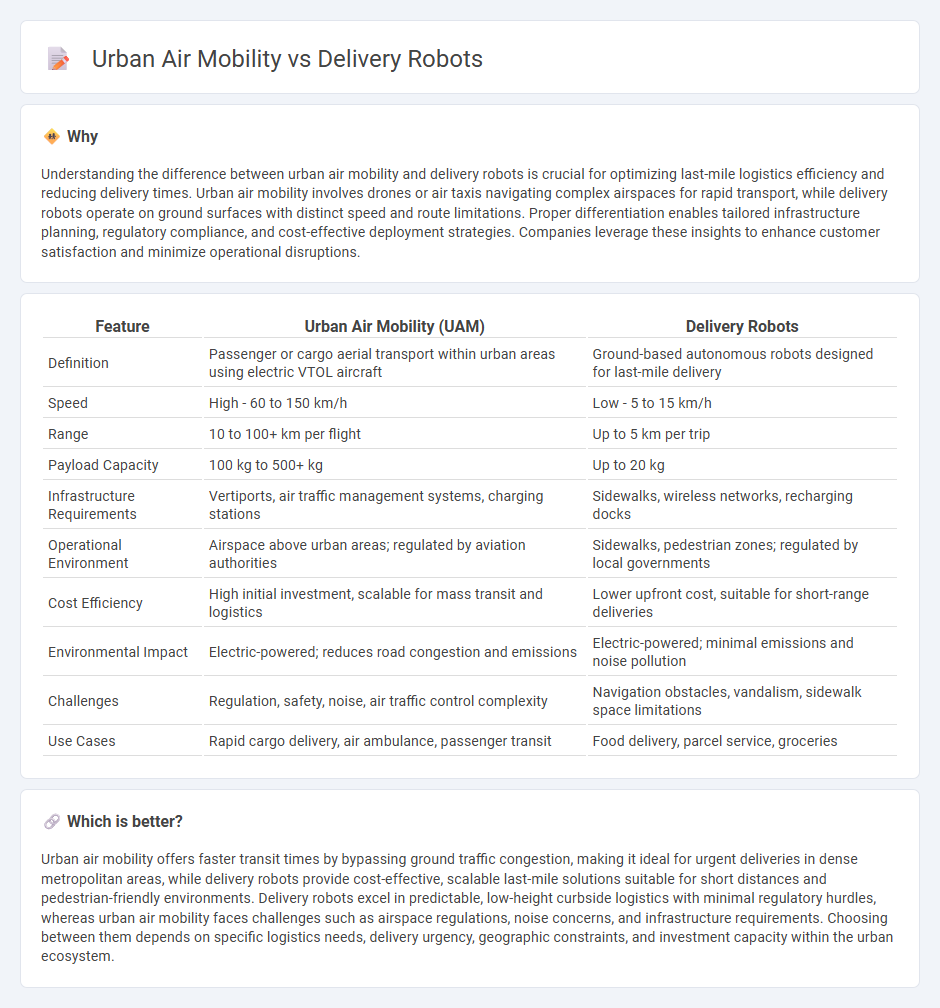
Urban air mobility leverages advanced drones and air taxis to streamline parcel delivery and reduce urban congestion, promising faster transit times and lower emissions. Delivery robots navigate sidewalks and pedestrian zones, offering cost-effective, last-mile solutions with real-time tracking and obstacle avoidance technologies. Explore how these innovative logistics methods transform urban delivery dynamics and reshape future cityscapes.
Why it is important
Understanding the difference between urban air mobility and delivery robots is crucial for optimizing last-mile logistics efficiency and reducing delivery times. Urban air mobility involves drones or air taxis navigating complex airspaces for rapid transport, while delivery robots operate on ground surfaces with distinct speed and route limitations. Proper differentiation enables tailored infrastructure planning, regulatory compliance, and cost-effective deployment strategies. Companies leverage these insights to enhance customer satisfaction and minimize operational disruptions.
Comparison Table
| Feature | Urban Air Mobility (UAM) | Delivery Robots |
|---|---|---|
| Definition | Passenger or cargo aerial transport within urban areas using electric VTOL aircraft | Ground-based autonomous robots designed for last-mile delivery |
| Speed | High - 60 to 150 km/h | Low - 5 to 15 km/h |
| Range | 10 to 100+ km per flight | Up to 5 km per trip |
| Payload Capacity | 100 kg to 500+ kg | Up to 20 kg |
| Infrastructure Requirements | Vertiports, air traffic management systems, charging stations | Sidewalks, wireless networks, recharging docks |
| Operational Environment | Airspace above urban areas; regulated by aviation authorities | Sidewalks, pedestrian zones; regulated by local governments |
| Cost Efficiency | High initial investment, scalable for mass transit and logistics | Lower upfront cost, suitable for short-range deliveries |
| Environmental Impact | Electric-powered; reduces road congestion and emissions | Electric-powered; minimal emissions and noise pollution |
| Challenges | Regulation, safety, noise, air traffic control complexity | Navigation obstacles, vandalism, sidewalk space limitations |
| Use Cases | Rapid cargo delivery, air ambulance, passenger transit | Food delivery, parcel service, groceries |
Which is better?
Urban air mobility offers faster transit times by bypassing ground traffic congestion, making it ideal for urgent deliveries in dense metropolitan areas, while delivery robots provide cost-effective, scalable last-mile solutions suitable for short distances and pedestrian-friendly environments. Delivery robots excel in predictable, low-height curbside logistics with minimal regulatory hurdles, whereas urban air mobility faces challenges such as airspace regulations, noise concerns, and infrastructure requirements. Choosing between them depends on specific logistics needs, delivery urgency, geographic constraints, and investment capacity within the urban ecosystem.
Connection
Urban air mobility and delivery robots revolutionize logistics by enabling faster, more efficient last-mile delivery through autonomous systems. Integration of drones and ground-based delivery robots reduces traffic congestion and carbon emissions, enhancing urban supply chain responsiveness. Advances in AI and IoT technologies facilitate seamless coordination between these delivery formats, optimizing route planning and real-time tracking.
Key Terms
Last-mile delivery
Delivery robots offer ground-based solutions for last-mile delivery, efficiently navigating sidewalks and urban environments with precise routing algorithms and obstacle detection technologies. Urban Air Mobility (UAM) leverages drones and autonomous aerial vehicles to bypass traffic congestion, enabling faster delivery times over longer distances in densely populated areas. Explore the evolving landscape of last-mile delivery to understand how these technologies reshape logistics and urban mobility.
Autonomous navigation
Delivery robots utilize ground-based sensors, LIDAR, and computer vision to autonomously navigate sidewalks and avoid obstacles, optimizing last-mile logistics. Urban air mobility (UAM) employs advanced GPS, radar, and AI-driven flight control systems for autonomous navigation through complex airspaces, enhancing urban transportation efficiency. Explore the latest innovations in autonomous navigation technologies across delivery robots and UAM to understand their impact on smart city logistics.
Airspace management
Delivery robots operate primarily on ground surfaces, requiring advanced navigation systems to maneuver pedestrians and urban infrastructure, while Urban Air Mobility (UAM) demands sophisticated airspace management to ensure safe integration with existing air traffic and compliance with aviation regulations. The complexity of UAM airspace management involves dynamic geofencing, real-time traffic coordination, and stringent communication protocols to prevent collisions and optimize flight paths in congested urban skies. Explore more about how innovative airspace management solutions are shaping the future coexistence of delivery robots and UAM technologies.
Source and External Links
How Do Food Delivery Robots Work? - Delivery robots are autonomous, sensor-equipped machines that use AI, GPS, and cameras to navigate streets and sidewalks, offer secure locked compartments for food, and provide contactless delivery mainly in urban and campus environments.
DoorDash rolls out food delivery robots in Los Angeles - DoorDash partners with Coco Robotics to deploy small, emission-free food delivery robots in cities like Los Angeles and Chicago, utilizing fleets remotely monitored by human operators to complete deliveries.
Level 4 Autonomous Delivery Robots | Ottonomy - Ottonomy's fully autonomous delivery robots operate indoors and outdoors with contextual navigation, safety sensors, contactless delivery via mobile QR codes, and environmentally friendly electric propulsion, serving food, groceries, and packages for major enterprises globally.
 dowidth.com
dowidth.com